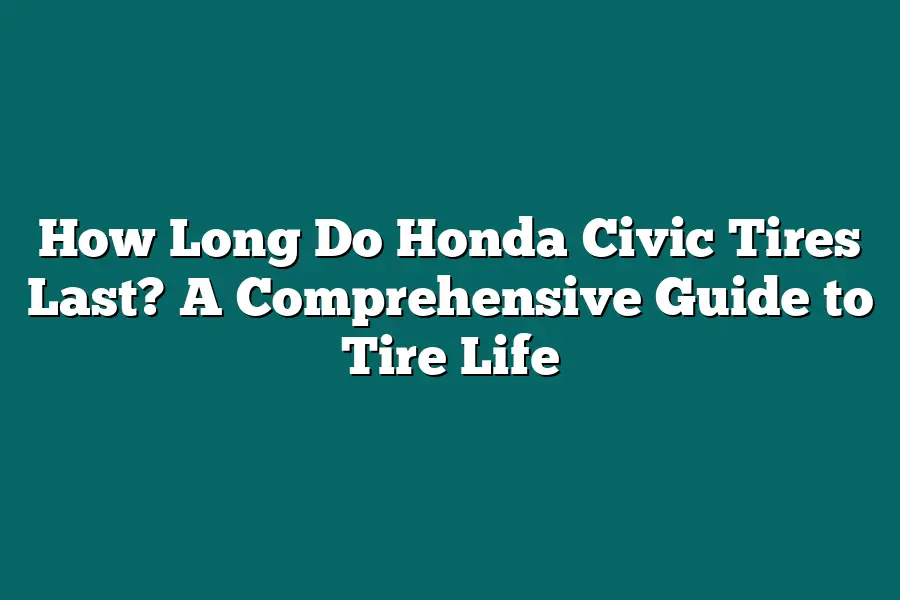The lifespan of Honda Civic tires depends on various factors, including driving conditions, tire quality, and maintenance. On average, a set of all-season tires can last around 50,000 to 80,000 miles, while high-performance tires may have a shorter lifespan of around 30,000 to 60,000 miles. Proper tire maintenance, such as regular rotations and pressure checks, can also help extend the life of your Honda Civic tires.
As a long-time Honda Civic enthusiast, I’ve always been fascinated by the relationship between my trusty ride and its humble tires.
Like many of us, I’ve wondered how long these crucial components will last, especially considering the varying conditions we encounter on our daily drives.
As someone who’s obsessed with getting the most out of my vehicle, I’ve dug deep to uncover the secrets behind Honda Civic tire life.
In this comprehensive guide, I’ll share the key factors that impact your tires’ lifespan – from road conditions and driving habits to maintenance routines and more.
Whether you’re a city dweller or an adventure-seeker, understanding these variables will help you make informed decisions about your vehicle’s well-being.
So, buckle up and let’s dive into the world of Honda Civic tires and explore what you can do to extend their life expectancy.
Table of Contents
Factors Affecting Tire Life: The Good, the Bad, and the Ugly
When it comes to Honda Civic tires, one question I hear a lot is: “How long do they last?” Well, my friend, the answer isn’t as straightforward as you might think.
Tire life depends on a multitude of factors, and in this section, we’re going to dive deep into the top five factors that affect tire longevity.
Road Conditions: The Good, the Bad, and the Ugly
The road you drive on can be a real tire-killer (pun intended).
Pavement quality is a major factor in tire wear.
Think about it – rough roads can cause constant vibrations, which lead to uneven tread wear.
And let’s not forget about potholes!
A single misstep can send your tire into an early retirement.
On the flip side, well-maintained roads with consistent surfacing can help extend tire life.
So, if you’re a city driver, consider yourself lucky (or unlucky, depending on how you look at it).
Driving Habits: The Aggressive, the Defensive, and the Reckless
Your driving style is another major factor in tire wear.
Speed demons, rejoice!
You might be surprised to learn that aggressive acceleration and braking can actually help wear down your tires faster.
However, this isn’t necessarily a bad thing – it’s just a sign that you’re getting the most out of your tires.
On the other hand, defensive driving habits can lead to longer tire life.
Maintaining a consistent speed, avoiding sudden stops, and using cruise control when possible can all contribute to reduced wear.
Vehicle Maintenance: The Tire Pressure Police and the Alignment Enthusiasts
Vehicle maintenance is crucial for tire longevity.
Proper tire pressure can make all the difference – underinflated tires lead to increased wear, while overinflated tires can cause uneven tread wear.
So, get into the habit of checking your tire pressure at least once a month.
And don’t forget about wheel alignment!
A misaligned vehicle can cause premature tire wear, especially on the inside and outside edges.
Regular alignments can help prevent this issue and extend your tire’s lifespan.
Tread Depth and Wear Patterns: The Good, the Bad, and the Ugly
Tire tread depth is a critical factor in tire life.
When your tires are worn down to 1/16 of an inch or less, it’s time to replace them – regardless of how well you’ve maintained your vehicle.
Worn-out tires can lead to reduced traction, increased stopping distances, and even blowouts.
But what about wear patterns?
Uneven wear can indicate underlying issues with your vehicle’s suspension or alignment.
Catching these problems early on can help prevent premature tire wear and extend the life of your tires.
Type of Tire and Its Intended Use: The Performance, the All-Season, and the Off-Road
Last but not least, let’s talk about the type of tire you’re using.
Different tire types are designed for specific driving conditions – whether it’s performance handling, all-season durability, or off-road adventure.
If you’re a performance enthusiast, you might be surprised to learn that high-performance tires can wear out faster than standard tires due to their softer compounds and more aggressive tread patterns.
On the other hand, all-season tires are designed for everyday driving and tend to last longer.
So, there you have it – the top five factors affecting tire life.
By understanding these factors, you can take steps to extend the life of your Honda Civic tires and avoid costly replacements.
Stay tuned for our next section, where we’ll dive into the world of tire maintenance and provide tips on how to get the most out of your tires!
Average Tire Life Expectancy
As a Honda Civic owner, you’re probably wondering how long your tires will last.
It’s a great question!
After all, you don’t want to be stuck with a blown-out tire on the side of the road.
So, let’s dive into some industry standards and benchmarks for Honda Civic tires.
According to the Tire Industry Association (TIA), the average lifespan of a passenger car tire is around 80,000 miles.
But, that number can vary depending on your driving habits and conditions.
For example, if you’re a city driver, you might get closer to 70,000 miles out of your tires.
On the other hand, if you’re a highway cruiser or an off-road enthusiast, you could squeeze out up to 100,000 miles.
Now, let’s look at some real-world examples based on various driving conditions:
City Driving
City drivers tend to put more stress on their tires due to frequent stops and starts.
This can lead to a shorter lifespan of around 60-70,000 miles.
For example, if you’re commuting in heavy traffic or doing a lot of stop-and-go driving, your tires might not last as long as someone who’s driving mostly highway miles.
Highway Driving
On the other hand, highway drivers often have smoother sailing and can expect to get closer to 80-90,000 miles out of their tires.
This is because there are fewer stops and starts, which reduces the wear and tear on the tires.
Off-Road or Extreme Weather Conditions
If you’re an off-road enthusiast or drive in extreme weather conditions (like snow or sand), your tire life can be significantly shorter.
In these cases, it’s not uncommon to see tire lifespans drop to around 40-50,000 miles.
This is because the tires are subjected to more stress and abuse from rough terrain, potholes, and harsh weather.
So, there you have it – a comprehensive guide to average tire life expectancy for Honda Civic owners.
Remember, proper maintenance, correct inflation, and gentle driving can all help extend the life of your tires.
And, if you’re wondering what happens when your tires do finally wear out, stay tuned for our next section: “How to Choose the Right Replacement Tires.”
How to Extend Tire Life
When it comes to your Honda Civic, you want to make sure that every component is running smoothly – including those all-important tires.
But just how long do Honda Civic tires last?
Well, that depends on a variety of factors, from proper maintenance and driving techniques to the quality of your tire game.
In this section, we’ll dive into the nitty-gritty of extending tire life, so you can hit the road with confidence.
Proper Tire Inflation and Maintenance Tips
Let’s start with the basics: proper tire inflation is key to maximizing tire life.
Under-inflated tires can lead to uneven wear, reduced traction, and even blowouts – not exactly what you want when you’re cruising down the highway.
So how do you ensure your Honda Civic tires are properly inflated?
- Check your owner’s manual for the recommended tire pressure (it should be listed).
- Use a reliable tire pressure gauge to check the air level.
- Adjust the pressure as needed, and consider investing in a tire pressure monitoring system (TPMS) for added peace of mind.
But proper inflation is just the beginning.
Regular maintenance can also make a big difference:
- Rotate your tires every 6-8 months or around 7,500 miles to ensure even wear.
- Have your wheels inspected and aligned regularly – misaligned wheels can cause uneven tire wear and reduced handling.
- Keep an eye out for signs of tire damage, such as cracks, bulges, or excessive wear, and address them ASAP.
Techniques for Reducing Wear and Tear
Now that we’ve covered the basics, let’s talk about some advanced techniques for reducing wear and tear on your Honda Civic tires:
- Slow down! Aggressive acceleration, braking, and cornering can all take a toll on your tires. Drive smoothly, and you’ll extend their lifespan.
- Gentle braking: Avoid slamming on the brakes – it’s hard on your tires (and your wallet). Instead, slow down gradually using gentle pressure.
- Avoid sudden turns: Sudden turns or quick lane changes can cause excessive tire wear. Take it easy, and you’ll be rewarded with longer-lasting tires.
The Importance of Regular Wheel Alignment and Balancing
Wheel alignment and balancing are often overlooked when it comes to extending tire life – but they’re crucial!
Misaligned wheels can cause uneven tire wear, reduced handling, and even affect your fuel efficiency.
- Have your wheels aligned every 12-15 months or around 12,000 miles.
- Balance your wheels regularly – improper balance can lead to vibration, reduced traction, and (you guessed it) shorter tire life.
The Benefits of Using High-Quality Tires and Tire Sealants
When it comes to extending tire life, quality matters.
Invest in high-quality tires that are designed for your Honda Civic’s unique needs:
- Look for tires with a good tread life rating – the higher the number, the longer they’ll last.
- Consider investing in all-season or winter tires if you live in an area with harsh weather conditions.
And don’t forget about tire sealants!
These clever products can help extend tire life by sealing small punctures and reducing air leaks.
Win-win!
That’s it – the lowdown on extending Honda Civic tire life.
By following these tips, techniques, and best practices, you’ll be well on your way to maximizing your tire lifespan.
Happy driving!
Final Thoughts
As I wrap up this comprehensive guide on how long Honda Civic tires last, I’m reminded that tire life is all about finding a balance between driving habits, vehicle maintenance, and road conditions.
It’s not just about installing a set of new tires and calling it a day – it’s an ongoing process that requires attention to detail and a willingness to adapt.
By understanding the factors that affect tire life, we can take steps to extend the lifespan of our Honda Civic tires.
Whether you’re a city dweller or an off-road enthusiast, this guide has provided valuable insights into the world of tire maintenance and care.
Remember, proper tire inflation, regular wheel alignment, and high-quality tires are just a few ways to get the most out of your ride.
With these tips in mind, you’ll be well on your way to enjoying a safer, more reliable driving experience for years to come.

